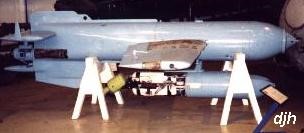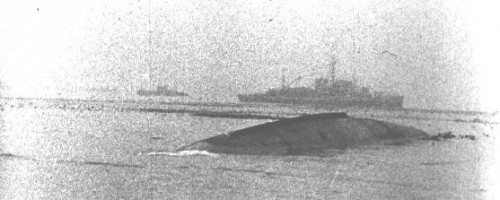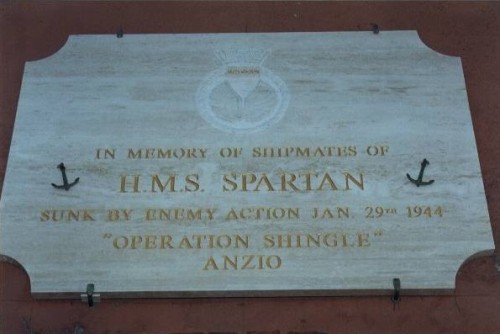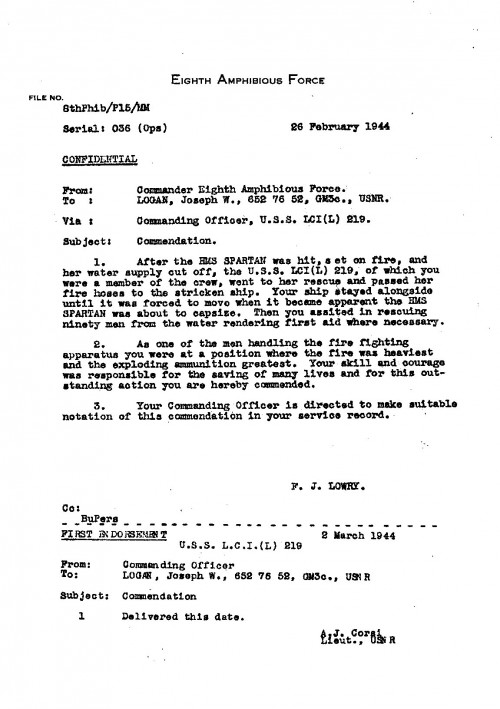The Loss of HMS Spartan 29th January 1944
THE LOSS OF HMS SPARTAN 29th JANUARY 1944
At sunset on 29th January, the Luftwaffe began a glide bomb attack on the ships in Anzio Bay. At the time of this attack, HMS Spartan was anchored providing AA protection for the ships in the vicinity of the beachhead. Smoke had been ordered in the anchorage but was not fully effective owing to the short time it was in operation and the strong breeze. HMS Spartan was making smoke from stem to stern but was not herself covered.
About 18 aircraft approached from the north and circling over land, delivered a beam attack against the ships that were silhouetted against the afterglow. The timing of the attack prohibited the aircraft from being sighted except by very few witnesses, and radar was ineffective owing to land echoes. By the time the warning had been received and HMS Spartan and other ships had opened fire in the general direction of the attack, six bombs were already approaching the anchorage, most of them falling into the water.
Shortly afterwards, at approximately 17:56, another glider bomb (radio-controlled Henschel Hs 293) was seen approaching the starboard side of the ship. This bomb was engaged by close range anti-aircraft fire; it was first thought likely to miss astern but is reported to have altered course during the final stage of its approach.
The bomb struck the ship at the after end of “B” funnel casing, started a heavy fire in the vicinity, the projectile passed through the ship and exploded high up on the port side of the main watertight sub-division containing “B” Boiler Room.
The main mast collapsed and boiler rooms were flooded. Steam and electrical power failed, a serious fire developed and the ship heeled over to port. Thus HMS Spartan was immobilized. About an hour after being hit, Spartan had to be abandoned in the dark, and 10 minutes later she settled on her beam-ends in about 25–30 ft (7.6–9.1 m) of water.
Five officers and 41 enlisted men were posted killed or missing presumed killed, and 42 enlisted men were wounded. Ron Douglas survived together with Acting Lieutenant J.S. Mackonochie, engineer.
The following extract is from Ronald Sired’s book, “Enemy Engaged” (published by William Kimber & Co. London, 1957, page 184) who was serving onboard HMS Laforey.
Just about this time I spotted a radio controlled-rocket bomb coming from a Do.217, and heading straight for Spartan. All our close-range weapons were directed towards the bomb, but it was travelling too fast for our fire to be accurate. I was able to see its red tail as it made for Spartan some 400 yards away. I watched helplessly as the bomb fell. I saw a bright flash as it exploded amidships, between the funnels, and a pillar of flame shot into the evening sky, momentarily lighting up Spartan. Serious fires were started and the Spartan quickly listed to port. By 1800 (this time must be incorrect as it does not fit with the Admiralty report) she was badly ablaze and, as the flames grew higher, I saw men dashing along her heeling decks with hoses and other fire fighting equipment. Other men dived over the side into the water.
Laforey moved closer to the strickened ship, which had listed further to port. Already her stern was below water. The after turret glowed red hot and sultry red flames reflected from gathering clouds. Laforey lowered both whalers and the motor-boat to pick up survivors. HMS Barndale was also standing close by, ready to go alongside Spartan at first opportunity to take off the wounded menbers of her ship’s company.
By 1840, the Spartan had listed some 70 degrees to port and I saw loose gear from her upper deck fall into the sea. Most of her ship’s company had jumped overboard and were being picked up by small craft. Her list increased and her fires died down as water flooded her compartments. From across the still waters came cries of men as they struggled in the oil-covered waters. The faint glow of torches flickered here and there as boats made their way to them.
By 1910, Spartan lay almost on her beam-ends and the water was lapping around her bridge. There were still a few intrepid sailors aboard her, helping wounded men to the boats alongside. Our motor-boat came alongside and took off her skipper, Captain McLaughlin. I saw a small cockle shell of a boat, a dinghy, containing one sailor, bobbing up and down close to the compass platform of the cruiser, searching for survivors. It was a queer sensation to watch the sea claim this once proud ship. The sea lapped over the upper-deck, which was now practically vertical and facing towards me.
By 1930, our scrambling nets which had been lowered over the side were swarming with oil-soaked survivors, and the first-aid and repair parties assisted them as they climbed inboard. There was considerable activity on board as the damage control parties dashed away for rum and blankets. Most of our ship remained closed-up in case of further attacks, but there were none.
By 1940, Spartan’s bridge and upperworks were underwater and I watched her starboard bilge keel appear as she slowly rolled over. The sea broke over her keel and her rudders and propellers were clearly visible as she sank from sight. By 2000 Spartan was no more. I had watched the foaming waters surge over her keel as she vanished, (In reality it was probably the darkness and not the sea that swallowed Spartan for, in fact, the ship’s keel remained visible).
The task of searching for her crew continued in the darkness and, as our mess-decks were crowded with survivors we moved away from the scene. Landing craft came alongside Laforey to take off Spartan’s survivors and at 2030, with the destroyer Loyal, we left for a night patrol at sea.
Joseph Logan, Gunners Mate, on board LCIL 219, together with his shipmates also assisted HMS Spartan. As Joseph described it, “LCI 219 quickly pulled alongside the Spartan in an effort to assist fighting the fires. I was manning one of the hoses. The landing ramps of the LCI were lowered down to the water surface to assist pulling the sailors out of the water. Other crew members of LCI 219 helped the Spartan sailors up the ramps. I seem to remember there were about 75 men pulled out of the water onto LCI 219. First aid was provided as needed.”. His son states that his father and other crew members used artificial respiration methods that he learned in the Boy Scouts to aid some of the British sailors.






My great grandfathers brother samuel cooper was on hms spartan when it went down we dont know if his body was ever found as my great grandfather wouldn’t talk about the war I’d love to find some more information as my daughter is studying world war 2 at school
Dear Crystal,
The information below has I know been sent to you direct but Charles and I thought that it would be helpful to others if some of the information we here in a reply to a comment.
There was a very good web-site written by David Hughes all about the sinking but in the last couple of months it has disappeared and I am trying to trace it.
However from
https://www.naval-history.net/xDKCas1944-01JAN.htm
Naval History Homepage and Site Search
Casualty Lists of the Royal Navy and Dominion Navies, World War 2
Researched & compiled by Don Kindell, all rights reserved
There is the following record:
COOPER, Samuel C, Ty/Leading Cook (S), D/MX 81086, MPK
Ty means Temporary
(S) means Steward
MPK means missing presumed killed
Using the Commonwealth War Graves Commission website, I found the following link
https://www.cwgc.org/find/find-war-dead/results?firstName=samuel&lastName=cooper&serviceNumber=81086
Commemorated at PLYMOUTH NAVAL MEMORIAL
Location: Devon, United Kingdom
Number of casualties: 23224
Cemetery/memorial reference: Panel 91, Column 2.
Memorial details
I also downloaded the attached commemorative certificate
So I suspect that Samuel’s body was never found. Another casualty who is listed as killed is also on the Plymouth memorial so from that I think nobody saw or knew what happened to Samuel
As I said at the beginning David Hughes had a very good site but it seems to have disappeared but I have another link that gives a bit more detail https://www.world-war.co.uk/spartan_loss.php3
Robin Hollamby. Website Editor.
Hello Robin/Crystal,
I am the David Hughes who created the Spartan website and are now long since retired from AUT.
So, it is now sadly apparent that someone at AUT has seen fit to ‘retire’ the website as an entity from the university server. I can only presume, that means, in effect, it will have been ‘binned’ as being an ephemeral ‘body of work’.
I guess that’s one of the problems with this form of media? I’m a ‘book-man’ myself and although it’s a stretch to think of such an event as a ‘book burning’ – to that end the Spartan site has been my first (and only) venture in ‘assembling’ a web-site.
All that aside, I would have thought AUT might have sent some sort of advisory email – if not an offer of an ‘archival-back-up’ disc? But – here we are!
My immediate thought is, if you are inclined, I could possibly find a ‘first contact’ name at AUT and see how ‘final’ the file deletion is. If that fails, I’d be happy to enter into some form ‘written exchange’ with you – given the realization that most of the original sources have now ‘passed’ and that my filing system is now scattered over multiple versions of Microsoft,et al.
Kind regards,
David Hughes
Hi. Can you post the URL of the HMS Spartan website? It might have been preserved by the Internet Archive (Archive.org). thanks
My grandfather Albert kilpatrick from Northern Ireland was aboard the Spartan when it sunk. He was rescued. Years later in approx 2008 he received a letter from another sailor who he had helped to save and the letter was thanking him for saving him. Unfortunately I cannot remember his name but I know he moved to Canada after the war. My grandfather died in 2011.
My great uncle was Petty Officer Stoker John Stitt who perished in the sinking of HMS Spartan in Anzio Bay. I remember photos of him from my grandmothers house but apart from that I know very little about him.
Hi. My grandfather was a stoker also. He survived. His name was joe Schofield. Maybe they knew each other.
My grandfather Stanley duckworth was a stocker on his spartan but he would never talk about his war life until one day before he passed we was watching some ww11 film where he said that was my ship that went down and walked out of the room
My father who’s name was Joseph Hanlon 21 years old was an AB on board the HMS Spartan.
I have only just found out this information as my father passed away in 1986 and never spoke of his time during the war.
I did know that one of the ship’s that my father served on sunk and that he was rescued after being in the water.
I would love to know any information of my father’s time during this terrible event.
He also served on the HMS Aurora.
My wife’s grandad Edward Jasper Webb was a survivor of this ship
Any news of any RM Bandsmen? I would dearly wish to know as I had a Link on my former Web Site for HMS Spartan. There may be some links still around on Web Archive, and my former Site is now managed by a Son of a past Crew Member and can be accessed via
http://www.hmsgambia.org
My late father served on HMS Spartan, and I believe that he was on board when she was sunk. He was CPO John Marshall, and served in various capacities, including engine room and anti-aircraft defense. He spoke little of the war days, and I am trying to piece together information that is available.
Pastor John Marshall Jr.
Goodlow, BC, Canada
My father Bill ( lofty) Rich was on the Spartan when she sank, thankfully he survived but was deeply scarred at the loss of his comrades He passed away in 1984 but was always proud of his Royal Navy service
Karen Holland
My mother in laws brother Tom Welsh was onboard and reported missing presumed killed